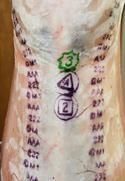
The meat grading systems of mutton and lamb in South Africa are in place to ensure quality meat production.
Meat carcasses are graded after slaughtering to indicate the age and fat content of the meat.
It also helps to determine the price of meat and makes it easier for consumers to identify their preferred quality of meat.
For example, for many consumers a carcass of A2 will be the ideal meat quality; a young lean animal with a slight layer of fat.
Other consumers may prefer more flavour and more fat and may want to choose a more economical grading such as C4.
Grading a carcass is done with a rollermark using food-grade vegetable-based ink that is totally safe and breaks down on cooking.
The same grading system is used for beef, mutton, lamb and goat, but the grading for pork is different due to different fat distribution on pork meat.
Meat Grading Markings
The quality of meat is indicated on the carcass and stamped in letters in a certain colour, depending on the age of the animal, e.g. ABAB. The fat content of the meat is indicated in a square with a number inside and any damage on the carcass is indicated by a 1, 2 or 3. Carcasses will also be stamped with an abattoir identification code, e.g. ZWZ.
The Age of an Animal
Sheep are divided into four age groups according to the number of adult teeth the animal has. At birth, lambs have eight baby teeth on their lower jaw. At approximately one year the central pair of baby teeth are replaced by two permanent incisors. The second pair of incisors appear around two years of age and at three and four, the third and fourth pairs of permanent teeth appear.
An A-grade carcass is the most tender meat and indicate a lamb - no permanent teeth - and is marked in purple. AB indicates two teeth (between one and two years of age) and is stamped on the carcass in green ink.
A brown mark is used for grading B, indicating an older sheep with four teeth and a carcass with a red grading of C will indicate an older animal (mutton) with six or more adult teeth. Gradings AB, B and C are considered adult animals, therefore considered ‘mutton’. The age class of an animal is indicated on the carcass with a row of three letters e.g. AAA.
Fat Content of Meat
The fat layer and the distribution of fat on the carcass are determined by expert meat graders which classify a carcass into seven fat classifications.
A fat classification of 0 means that the carcass has no fat, while a classification of 6 means that a carcass is excessively overfat.
The fatness class of an animal is indicated by a triple number such as 222.
By Marinda Louw
 Livestock farming in South Africa is a large part of the country's agricultural sector and includes the production of cattle, dairy, pigs, s...
Livestock farming in South Africa is a large part of the country's agricultural sector and includes the production of cattle, dairy, pigs, s... Sheep farming is done all over South Africa, but is traditionally concentrated in the more arid regions of the country. Although the income ...
Sheep farming is done all over South Africa, but is traditionally concentrated in the more arid regions of the country. Although the income ...